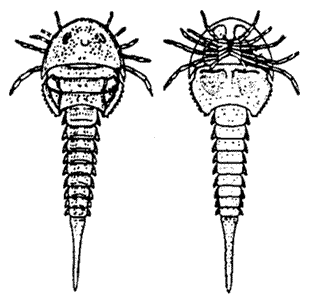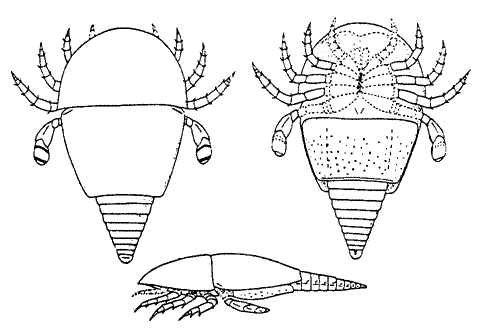Chasmataspida
Cambrian to Devonian
Chasmataspida Caster & Brooks, 1956
 The Chasmataspida are primitive merostomatans, possessing a narrow, eurypterid-like cephalothorax and somewhat trilobite-like appearance. Originally considered rare, a number of recent discoveries suggest that chasmataspids were a more widespread and common group than previously realized. Obviously, the similarity with Eurypterids results in some confusion from both sides (some Eurypterids have turned out to be chasmataspids, while a specimen discovered in 1987 by early fish expert Philippe Janvier, from the Middle Devonian (Givetian/frasnian) Do Son Formation of the Do Son peninsula in northern Vietnam, and tentatively referred to the Chasmataspida turned out to be a eurypterid of the family Carcinosomatidae.)
The Chasmataspida are primitive merostomatans, possessing a narrow, eurypterid-like cephalothorax and somewhat trilobite-like appearance. Originally considered rare, a number of recent discoveries suggest that chasmataspids were a more widespread and common group than previously realized. Obviously, the similarity with Eurypterids results in some confusion from both sides (some Eurypterids have turned out to be chasmataspids, while a specimen discovered in 1987 by early fish expert Philippe Janvier, from the Middle Devonian (Givetian/frasnian) Do Son Formation of the Do Son peninsula in northern Vietnam, and tentatively referred to the Chasmataspida turned out to be a eurypterid of the family Carcinosomatidae.)
In both Chasmataspis and Diploaspis at least, the opisthosoma is subdivided into a pre- and postabdomen, with the latter consisting of 9 segments. The number of post-cephalic segments in these animals represents an increase in at least three both on the number of segments of the xiphosurids proper and on the emeraldellids. The respiratory apparatus is limited to the preabdomen.
Caster & Brooks (1956) originally described Chasmataspida as an order within the Xiphosurida (= Xiphosura). Størmer (1972) altered Chasmataspida to Chasmataspidida, though this seems an unnecessary and cumbersome variation. For a while regarded as unusual basal or ancestral xiphosurans, Chasmataspids may actually be closer to Eurypterids. Phylogenetic hypotheses include: the sister group of eurypterids (Eldredge 1974), as both share features such as paddles, a polyphyletic group with Diploaspis close to the ancestry of arachnids (Bengström 1979). and sister group to eurypterids and arachnids (Dunlop & Selden 1997). However, recent discoveries have revealed that chasmataspids possess both a metastoma and a genital appendage, both typical diagnostic eurypterid characteristics. This supports Eldredge's thesis that the Chasmataspida and the Eurypterida are sister groups; i.e. that they both shared a common ancestor, together with which they form a single clade. Chasmataspids differ from Eurypterids in their different opisthosomal tagmosis and the presence of genal spines and perhaps also ophthalmic ridges. The position of the scorpions, which some researchers consider as a sister group of eurypterids (see Dunlop & Selden 1997) further complicates things. My own completely unstudied opinion on all this is that either Chasmataspids and the Eurypterids evolved form a common ancestor some time in the Cambrian, or that Eurypterids evolved from Chasmataspids, while scorpions are an early off-shoot of specialized Eurypterids (e.g. Mixopterus-like forms). Arachnids in turn (spiders, mites, etc) evolved from early Scorpions (Scorpions are traditionally included within the Arachnida).
Image: Forfarella mitchelli, length about 17 mm (scale bar 2.5 mm). Early Devonian of South Euramerica (Midland Valley of Scotland); family Diploaspididae. From Dunlop et al. (1999), by, and courtesy of, Lyall Anderson.
Chasmataspis laurencii
Darriwilian Age (Ordovician) of Laurentia
figure from Delle Cave & Simonetta 1991)

 Chasmataspidae Caster and Brooks 1956
Chasmataspidae Caster and Brooks 1956
time range:
Darriwilian Age (Ordovician) to Early Devonian
known distribution: Laurentia (Canada and USA (Tennessee)), Euramerica
habitat: Marginal Marine, Brackish water, amphibious
representative taxa: Chasmataspis laurencii Caster and Brooks 1956
description: Large chasmataspids with elongate postabdomen and long telson.
reference: Caster & Brooks (1956)
notes: For a long time Chasmataspis laurencii was the only known species. However, some Furongian fossils provisionally described as merostomes by Wahlman & Caster (1978) show a rounded prosoma and a long postabdomen, a consistent with them being a series of superimposed resting traces of an animal similar to Chasmataspis. There are also two early Devonian species (Størmer, 1972), and some material formerly described as eurypterids from the early Devonian of Siberia may also belong to this group (Størmer, 1972). Delle Cave & Simonetta's reconstruction of Chasmataspis Iaurencii is, to quote from their review: "obviously tentative, based as it is on published evidence. The walking legs are very incompletely known: we assumed them to be basically similar, but to be progressively longer caudally in order to balance the animal when walking. The eurypterid Mixopterus kiasri Størmer, though of much larger size, has a shape recalling that of Chasmataspis and the proportions of the legs have been based on this indirect evidence. As is clear from the figure, the tagmosis of Chasmataspis may be compared with the tagmosis of the later, Devonian, Diploaspis....The opisthosoma is subdivided into a pre- and postabdomen, with the latter consisting of 9 segments. The number of segments incorporated in the preabdomen is not known, but our tentative suggestion (Simonetta & Delle Cave, 1981) of three is still valid."
The respiratory apparatus seems to be more sophisticated than that of the Diploaspididae, and apparently includes had a pair of pouches opening by some sort of slits. Such an apparatus, being almost completely closed, certainly could favor life under comparatively dry conditions. Under water it could function only if there was some sort of efficient pumping mechanism. With 3 or 4 preabdomen segments, a modified system of intersegmental muscles and tendons may have been evolved to act as a pump. It is also possible that Chasmataspis was an intertidal dweller, foraging at low tide on stranded organisms. The existence of Ordovician (or even Furongian) "strandloopers" does not seem unreasonable, in view of the discovery of truly terrestrial Arachnids in the Silurian, and in fact was a logical step in the progression of life from the ocean to dry land.
Image: Chasmataspis laurencii Darriwilian Age (Ordovician) of Laurentia, from Delle Cave & Simonetta (1991).

Diploaspis casteri
early Emsian epoch (Devonian)
Armorica / tropical South Euramerica (Germany)
figure from Delle Cave & Simonetta 1991)
 Family Diploaspididae Størmer, 1972
Family Diploaspididae Størmer, 1972
time range: Early to Middle Devonian
known distribution: Armorica, South Euramerica (Germany and Scotland); Siberia (Severnya Zemla archipelago)
habitat: Marginal Marine to Brackish and Fresh water
representative taxa: Diploaspis casteri Størmer, 1972; Forfarella mitchelli Dunlop, Anderson, and Braddy, 1999; Achanarraspis reedi Anderson, Dunlop, and Trewin, 2000
references: Størmer (1972); Dunlop et al. (1999); Anderson et al. (2000).
description: Small to very small chasmataspids with semicircular or subrectangular carapace, a distinctly tapering postabdomen and a short telson. The respiratory apparatus is limited to the preabdomen and, in contrast to the Chasmataspidae, constitutes a simple situation recalling that of the Xiphosurans.

Achanarraspis reedi Anderson, Dunlop, and Trewin, 2000
length about 30 mm (scale bar 5 mm)
Late Eifelian of south Euramerica (Caithness, Scotland); family Diploaspididae
This genus is distinguished by a carapace longer than the pre-abdomen, and a spatulate telson (the leaf-like structure at the "tail")
Image from Anderson et al. (2000), by and courtesy of, Lyall Anderson.
Family Heteroaspididae Størmer, 1972
time range: early Devonian (early Emsian)
known distribution: Armorica / South Euramerica (Germany - Alken)
habitat: Marginal Marine or Brackish Fresh water
representative taxon: Heteroaspis novojilovi Størmer, 1972
reference: Størmer (1972)
notes: may turn out to be synonymous with the Diploaspididae
Anderson, LI, JA Dunlop, & NH Trewin (2000), A Middle Devonian chasmataspid arthropod from Achanarras Quarry, Caithness, Scotland. Scot. J. Geol., 36: 151-158.
Anderson, LI & PA Selden 1997), Opisthosomal fusion and phylogeny of Palaeozoic Xiphosura. Lethaia, 30: 19-31, abstract
Bengström, J (1979), Morphology of fossil arthropods as a guide to phylogenetic relationships, in AP Gupta (ed.), Arthropod Phylogeny. Van Nostrand Reinhold, pp. 3-56.
Caster, E & HK Brooks (1956), New fossils from the Canadian-Chazyan (Ordovician) hiatus in Tennessee. Bull. Am. Paleontol. 36:157-199.
Delle Cave, L & AM Simonetta (1991), Early Paleozoic Arthropoda and problems of arthropod phylogeny; with some notes on taxa of dubious affinities, in AM Simonetta & S Conway Morris (eds.), The Early Evolution of Metazoa and the Significance of Problematic Taxa. Cambridge U. Press, pp. 189-244.
Dunlop, JA & PA Selden (1997), The early history and phylogeny of the chelicerates, in RA Fortey & RH Thomas (eds.) Proceedings of the International Symposium on the Relationship of the Major Arthropod Groups. Chapman & Hall, pp. 221-35.
Dunlop, JA, LI Anderson, & SJ Braddy (1999), Forfarella mitchelli gen. et sp. nov., a chasmataspid from the Lower Devonian of the Midland Valley of Scotland. Trans. R. Soc. Edinburgh: Earth Sci, 89: 161-165.
Eldredge, N (1974), Revision of the Suborder Synziphosurina (Chelicerata: Meristmata), with remarks on merostome phylogeny. Am. Mus. Nov. #2543, 41 pp.
Størmer, L (1972), Arthropods from the Lower Devonian (Lower Emsian) of Alken an der Mosel, Germany . Part 2: Xiphosura. Seckenbergiana Lethaea 53: 1-29.
Wahlman, GP & KE Caster (1978), Bearing of New Texas Upper Cambrian arthropods on merostome classification. Geol. Soc. Am., (abstr.) 10: 268.
 The Chasmataspida are primitive merostomatans, possessing a narrow, eurypterid-like cephalothorax and somewhat trilobite-like appearance. Originally considered rare, a number of recent discoveries suggest that chasmataspids were a more widespread and common group than previously realized. Obviously, the similarity with Eurypterids results in some confusion from both sides (some Eurypterids have turned out to be chasmataspids, while a specimen discovered in 1987 by early fish expert Philippe Janvier, from the Middle Devonian (Givetian/frasnian) Do Son Formation of the Do Son peninsula in northern Vietnam, and tentatively referred to the Chasmataspida turned out to be a eurypterid of the family Carcinosomatidae.)
The Chasmataspida are primitive merostomatans, possessing a narrow, eurypterid-like cephalothorax and somewhat trilobite-like appearance. Originally considered rare, a number of recent discoveries suggest that chasmataspids were a more widespread and common group than previously realized. Obviously, the similarity with Eurypterids results in some confusion from both sides (some Eurypterids have turned out to be chasmataspids, while a specimen discovered in 1987 by early fish expert Philippe Janvier, from the Middle Devonian (Givetian/frasnian) Do Son Formation of the Do Son peninsula in northern Vietnam, and tentatively referred to the Chasmataspida turned out to be a eurypterid of the family Carcinosomatidae.)


 Family Diploaspididae Størmer, 1972
Family Diploaspididae Størmer, 1972 